
The Ichneumonidae, also known as the ichneumon wasps, Darwin wasps, or ichneumonids, are a family of parasitoid wasps of the insect order Hymenoptera. They are one of the most diverse groups within the Hymenoptera with roughly 25,000 species currently described. However, this likely represents less than a quarter of their true richness as reliable estimates are lacking, along with much of the most basic knowledge about their ecology, distribution, and evolution. Ichneumonid wasps, with very few exceptions, attack the immature stages of holometabolous insects and spiders, eventually killing their hosts. They thus fulfill an important role as regulators of insect populations, both in natural and semi-natural systems, making them promising agents for biological control.

Fire-coloured beetles are the beetles of the Pyrochroidae family. Adults measure 4-20 mm; larvae reach 25 mm. Larvae of Pyrochroinae are found under moist bark of dead trees. They are probably mostly fungivorous, although they may become cannibalistic if too crowded.

Banchinae is a subfamily of ichneumonid parasitoid wasps containing about 1,500 species; the genera Glypta and Lissonota are very large. The three tribes are all distributed worldwide.
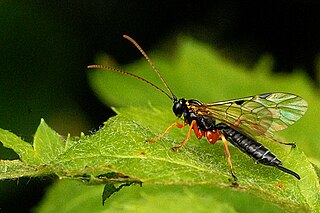
Pimplinae are a worldwide subfamily of the parasitic wasp family Ichneumonidae.
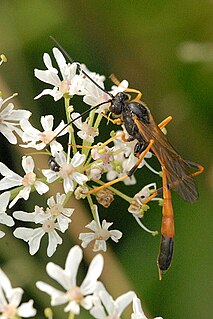
Anomaloninae is a subfamily of parasitoid wasps in the family Ichneumonidae. Several species provide beneficial services to humans by attacking forest or orchard pests.

Campopleginae is a large subfamily of the parasitoid wasp family Ichneumonidae with a world-wide distribution. Species in this subfamily have been used in the biological control of the alfalfa weevil, clover weevil, various species of Heliothis, oriental army worm, European corn borer, larch sawfly, and others.
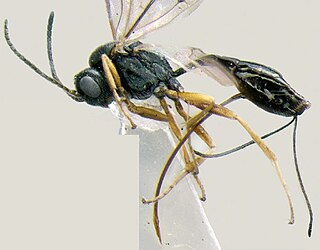
Tersilochinae is a worldwide subfamily of the parasitic wasp family Ichneumonidae.

The Labeninae is a subfamily within the parasitic wasp family Ichneumonidae . There are 12 extant genera, grouped within four tribes, that exhibit a predominantly Gondwanan distribution - most genera and species are found in Australia and South America. A few species of Labena and Grotea are found in North America, with hypotheses suggesting that the group radiated on Gondwanaland prior to the separation of Australia but after the separation of Africa/India/Madagascar.

The Alysiinae are a subfamily of braconid parasitoid wasps with over 1000 described species. Several species have been used in biocontrol programs. They are closely related to the Opiinae.
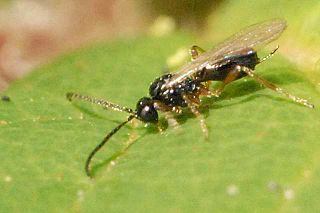
Blacini is a tribe of braconid Parasitoid wasps. Formerly the subfamily Blacinae, this group was demoted to a tribe and placed within the Brachistinae based on molecular evidence in 2011.

Trogus is a genus of parasitoid wasp found in the Holarctic and Neotropic regions. It is placed in the subfamily Ichneumoninae. Trogus species are parasites of larvae and pupae of the swallowtail butterfly family, Papilionidae. The genus consists of twelve extant and one extinct species.

Ephialtini is a tribe of ichneumon wasps in the family Ichneumonidae. There are about 53 genera and at least 120 species in Ephialtini.

Brachistinae is a subfamily of braconid wasps in the family Braconidae.

Euceros is a worldwide genus of ichneumon wasps in the family Ichneumonidae. It is the sole genus of the subfamily Eucerotinae.
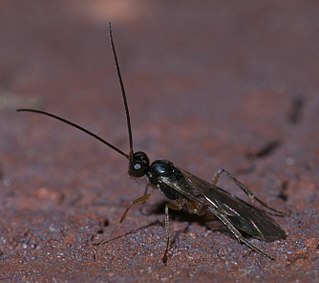
Phygadeuontini is a tribe of ichneumon wasps in the family Ichneumonidae. It is the only tribe in the subfamily Phygadeuontinae. There are about 123 genera in 12 tribes worldwide.
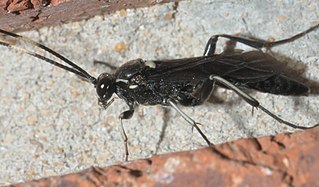
Ichneumonini is a tribe of ichneumon wasps in the family Ichneumonidae. There are at least 20 genera and 60 described species in Ichneumonini.

Limonethe is a genus of ichneumon wasps in the family Ichneumonidae. There are about five described species in Limonethe. They can be distinguished from similar genera based on the nearly square-shaped areolet and the large and dense punctures on the post-petiole. Many also have infuscated wings, a red abdomen, black head and mesosoma with narrow white markings along the inner eye margins. Limonethe occurs in the New World from Canada to Argentina.
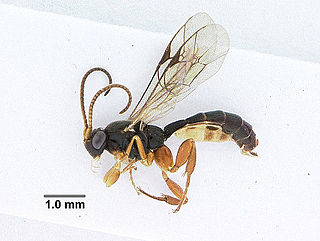
Orthocentrinae is a subfamily of ichneumon wasps in the family Ichneumonidae. There are about six genera in Orthocentrinae.

Rhyssinae is a subfamily of parasitoid wasps in the family Ichneumonidae. It contains eight genera and 259 described species, but there are likely many undiscovered species.

Heresiarchini is a tribe of ichneumon wasps in the family Ichneumonidae. There are about 7 genera and 19 described species in Heresiarchini.





















